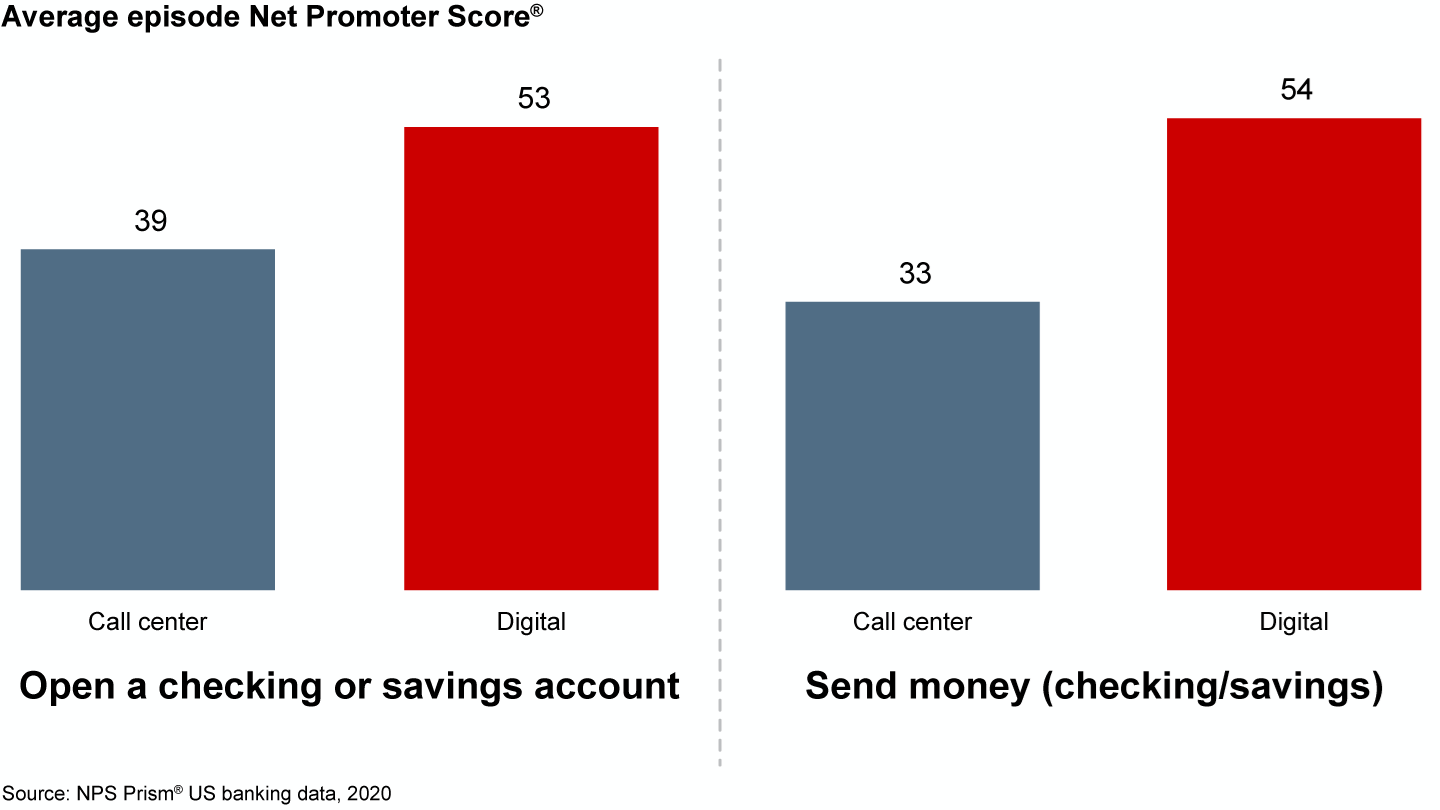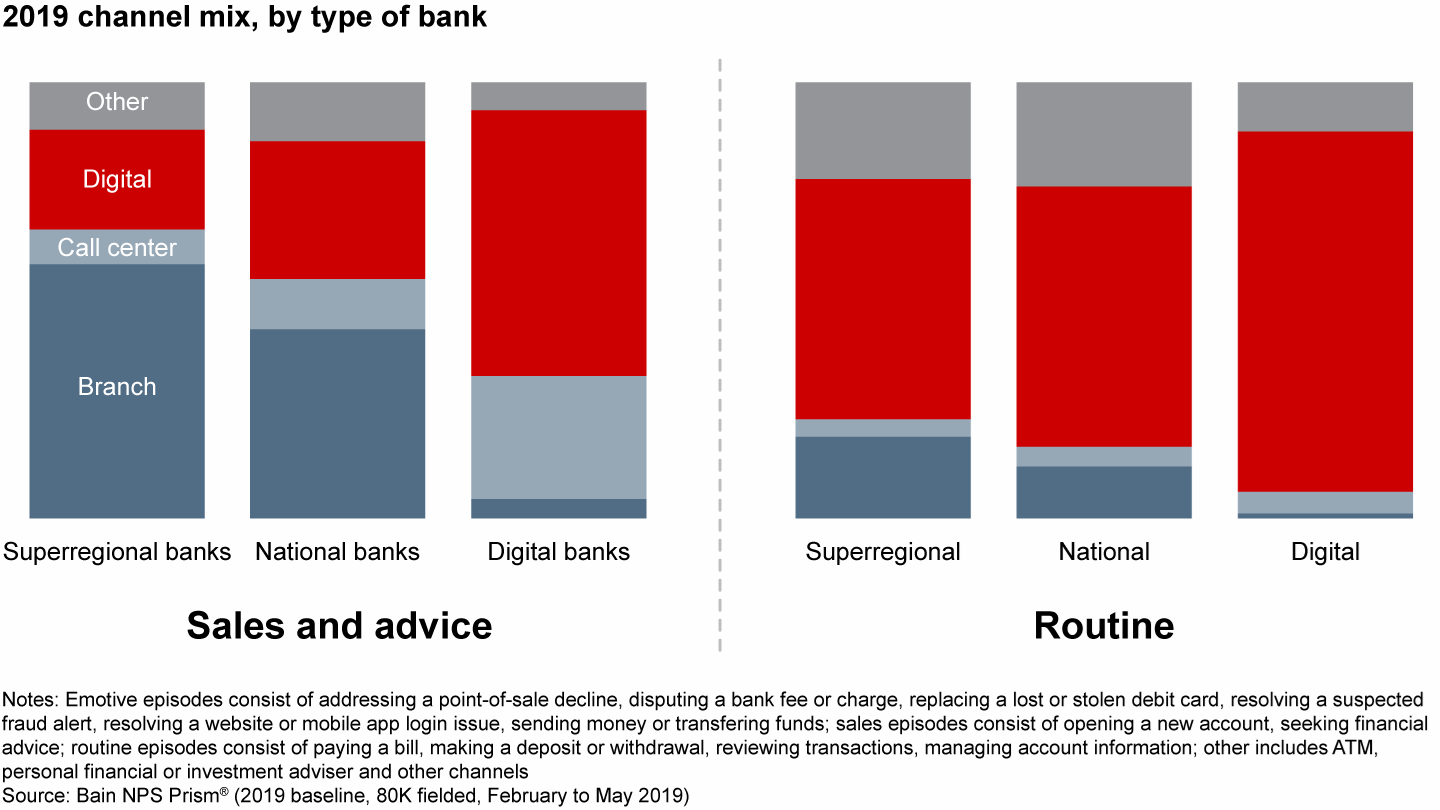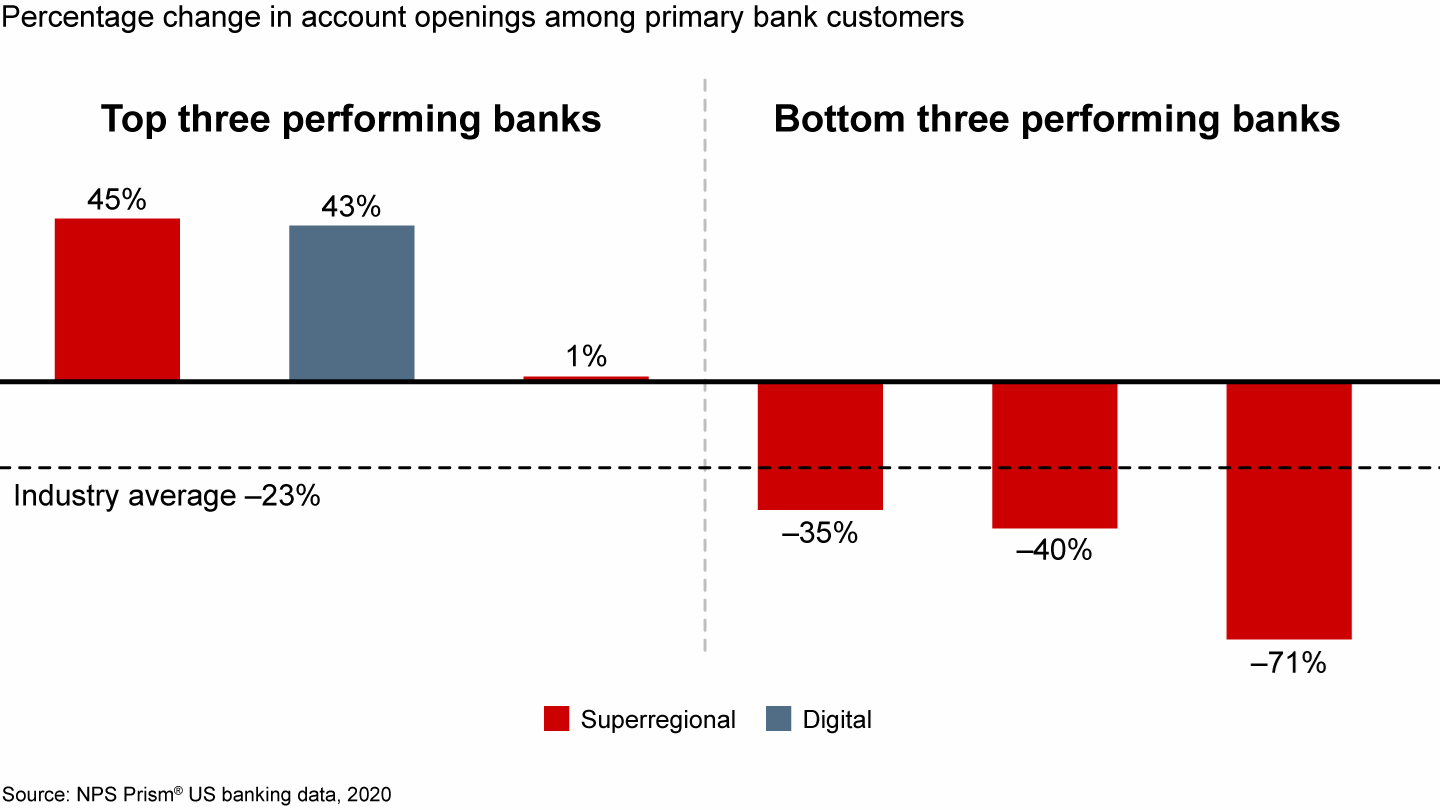Brief

The Covid-19 pandemic forced banks and their customers to adapt quickly to limitations on physical interactions. As a result, digital adoption by bank customers has accelerated. Many have touted this as a dramatic shift, and most have assumed that digital natives and large national banks would emerge as the winners, given their across-the-board investment in digital enablement.
Our examination of data from NPS Prism®, Bain’s competitive benchmarking service, combined with data from banks reveals a surprisingly different reality. In fact, one superregional bank’s performance illustrates how a focused digital strategy can yield shocking results.

NPS Prism℠
Prioritize the customer interactions that matter most. NPS Prism is a unique customer experience benchmarking service that guides your creation of game-changing customer experiences. Learn more →
The swing to digital, while meaningful, has turned out to be far less dramatic than most expected. Banks have kept at least some of their branches open, even as they reduced branch staffing and hours and limited the number of customers they allowed in. Branch transaction volumes have declined, but only by 30% to 50% in some instances. Compared with most retail categories (other than grocery), this decline is strikingly small.
Meanwhile, digital transactions are, indeed, up. But for many banks, the number of transactions completed in digital channels appears to have grown less than many anticipated—10% to 20%.
We attribute much of this shift to the specific changes in transaction mix for each channel. Branches are executing fewer low-involvement transactions, such as check deposits or cash transactions, but customer interactions involving advice or significant complexity have declined far less. And some activity has shifted not to digital, but to contact centers, where call volumes have increased. By and large, customers are still using human channels to resolve problems, seek advice and open new accounts.
Over the long term, of course, the pandemic-driven acceleration toward digital will help banks reduce costs and provide a better customer experience, resulting in higher Net Promoter® scores and greater customer lifetime value. That’s a sliver of good news for bankers who find themselves beleaguered by all that the pandemic has wrought. As one bank executive told us, “We’ve been in survival mode for six weeks straight. It’s exhausting.”
Simply put, customers prefer digital
While the shift to digital may be less dramatic than many expected, it’s important to note that digital hasn’t simply filled a need created by the pandemic; it has also improved the customer experience, often markedly so. NPS Prism data shows that the Net Promoter Score® for opening a checking or savings account is 53 when completed successfully in digital channels, but 39 when done through a bank’s contact center (see Figure 1). And we estimate that the cost of completing this customer “episode,” i.e., the series of discrete actions a customer takes to satisfy a specific need, is 80% to 90% lower when completed digitally rather than in a branch or on the phone.
Customers give much higher marks to digital on key episodes


Despite this validation of successful digital investments, however, bankers shouldn’t overlook a critical distinction: The impact of digital adoption differs significantly by episode, by customer segment and—most importantly—by bank. A deeper dive into the data reveals surprising insights about which banks stand to win or lose, and how bankers should invest to emerge stronger from the pandemic than they entered.
Winners and losers
Direct banks, as noted above, entered 2020 with strong digital adoption and already executed the vast majority of customer episodes with minimal support needed from contact centers. Most of the traditional large national banks also began the year with high overall digital enablement. But superregional banks—large banks that typically span multiple states but lack a truly national footprint—entered 2020 with a wider variety of starting points. We can see differences in bank readiness by lining up the banks in descending order, from the types of banks with the highest percentage of transactions executed with human intervention to the lowest (see Figure 2).
Banks' digital push: Plenty of progress, and lots of variety


While virtually all banks have moved the majority of routine transactions to digital, only a few have successfully converted complex interactions involving sales or advice. Because the overall Net Promoter impact of these episodes varies according to volume and the emotional or experiential complexity of the interaction, some banks that have invested selectively in digital have reaped outsized rewards.
For example, consider how banks fared in new-account openings as Covid-19 slowed virtually all commercial activity. While new-account openings fell by an average of 23% across our sample of national, superregional and direct banks, two banks outperformed by a remarkable degree: one was a digital bank, but the other was a superregional (see Figure 3). And therein lies the surprise. How did a superregional outperform almost all the other banks in new-account openings?
It turns out that, much like the digital-native direct banks, this superregional had invested heavily in enabling the account-opening episode. It had built the necessary digital capability and communicated its advantage to customers, accelerating adoption. As a result, this bank fared extremely well: new-account openings soared by 45%, outperforming all the other banks in our sample.
The case for focusing on select digital episodes


Beware of blind spots
There is a valuable lesson there for virtually all banks. To seize it, however, bank executives may need to overcome a persistent and highly prevalent set of digital blind spots.
For example, most bankers have pretty good visibility into the number of transactions executed in each channel. They also have customer feedback ratings, such as the Net Promoter Score, in those channels. But they generally cannot tell how many customers fail from one channel into another. Worse, they lack reliable measures of the impact those failed attempts have on customer Net Promoter scores, customer retention, costs and customer value. So they don’t know what it would be worth to eliminate those failures.
Similarly, most executives lack a clear assessment of how their own bank’s capabilities compare to those of competitors. As a result, they often mistakenly assume that everyone is in the same boat: “Our account openings are down, but so are everyone else’s.” Not necessarily.
And some don’t clearly understand how some episodes affect customer value much more than others. Too often, they overinvest in the wrong digital experiences—and miss important opportunities to create genuine value for customers by investing in the right ones.
A postpandemic action plan
Getting ahead of the pack in digital without “breaking the bank” requires eliminating those blind spots and focusing precious resources on the handful of customer episodes that matter most. Four imperatives:
- Determine which episodes matter most to your customers, and measure with clarity how you perform on those episodes relative to your competitors.
- Closely examine your gaps and opportunities. Why do you do well (or poorly) on episodes related to customer acquisition and retention, for example? How much do you need to improve the most important episodes? Is your opportunity bigger for simplifying the episode, making it more reliable, or for adding new functionality?
- Focus your resources differentially on the episodes that the data show create the greatest potential to accelerate growth, improve customer relationships and increase the value of the customer base, even at the expense of forgoing flashier or more popular digital projects.
- Create a portfolio approach to investment. Make sure to balance longer, harder projects with a few that can produce quick wins (especially focused on channel shifts or cost reduction) as you build the foundation for a sustained push to a leadership position.
The pandemic accelerated digital adoption, but this new momentum will outlast the current crisis. Smart, focused investments to develop and enhance digital capabilities should focus on the episodes that matter most to customers and offer the greatest opportunity for your own organization. Without a clear understanding of how you perform on each episode compared with competitors (and leaders in other industries), you’re flying blind into the postpandemic unknown.
The authors would like to thank Cassy Reichert and Casey Stelmach for their contributions to this article.
NPS Prism®, Net Promoter®, Net Promoter Score®, Net Promoter® and NPS® are registered trademarks and service marks of Bain & Company Inc., Fred Reichheld and Satmetrix Systems, Inc.

Coronavirus
The global Covid-19 pandemic has extracted a terrible human toll and spurred sweeping changes in the world economy. Across industries, executives have begun reassessing their strategies and repositioning their companies to thrive now and in the world beyond coronavirus.